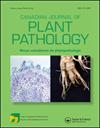西部红杉-自然历史和病理系统,重点是雪松叶枯病
IF 1.5
4区 农林科学
Q3 PLANT SCIENCES
引用次数: 0
摘要
西部红杉(Thuja plicata) (WRC)的木材特性在太平洋海岸第一民族的传统实践中受到尊敬,并在特殊商业用途中受到重视。在不久的将来,WRC的采伐将从旧的生长转向第二生长,然而,它的文化意义将继续存在,木材优越的物理和化学特性意味着它将保持高需求。调查和了解该物种在面对气候变化时对环境和病原体胁迫的适应,可以确保WRC的可持续供应。在影响WRC的病原菌中,雪松叶枯病(Didymascella thujina) (CLB)最为严重。这种叶面疾病感染幼苗和成熟树木的小叶,造成光合面积的损失,导致生长下降或死亡。这种病在苗木上比在成熟树木上更严重。在WRC原生范围内,未来预估的气候预计将增加CLB的流行率和损害。这篇综述总结了知识的状态,并强调了最近的进展在理解的Thuja - Didymascella病理系统。本文章由计算机程序翻译,如有差异,请以英文原文为准。
Western redcedar — natural history and pathosystems, with emphasis on cedar leaf blight
Abstract The wood properties of western redcedar (Thuja plicata) (WRC) are revered in traditional practices by Pacific Coast First Nations and valued for speciality commercial purposes. In the near future, WRC harvesting will shift to second growth from old-growth, however, its cultural significance will persist, and the superior physical and chemical properties of the wood mean that it will remain in high demand. Investigating and understanding the adaptations of the species to environmental and pathogen stress in the face of changing climates can assure a sustainable supply of WRC. Of the pathogens affecting WRC, cedar leaf blight (Didymascella thujina) (CLB) is the most severe. This foliar disease infects the leaflets of seedlings and mature trees, causing a loss of photosynthetic area resulting in decreased growth or mortality. The disease is more severe on nursery seedlings than mature trees. Future projected climates in WRC’s native range are expected to increase the prevalence of, and damage from CLB. This review summarizes the state of knowledge and emphasizes recent advances in the understanding of the Thuja – Didymascella pathosystem.
求助全文
通过发布文献求助,成功后即可免费获取论文全文。
去求助
来源期刊
CiteScore
4.50
自引率
5.00%
发文量
56
审稿时长
6-12 weeks
期刊介绍:
Canadian Journal of Plant Pathology is an international journal which publishes the results of scientific research and other information relevant to the discipline of plant pathology as review papers, research articles, notes and disease reports. Papers may be submitted in English or French and are subject to peer review. Research articles and notes include original research that contributes to the science of plant pathology or to the practice of plant pathology, including the diagnosis, estimation, prevention, and control of plant diseases. Notes are generally shorter in length and include more concise research results. Disease reports are brief, previously unpublished accounts of diseases occurring on a new host or geographic region. Review papers include mini-reviews, descriptions of emerging technologies, and full reviews on a topic of interest to readers, including symposium papers. These papers will be highlighted in each issue of the journal and require prior discussion with the Editor-in-Chief prior to submission.

 求助内容:
求助内容: 应助结果提醒方式:
应助结果提醒方式:


